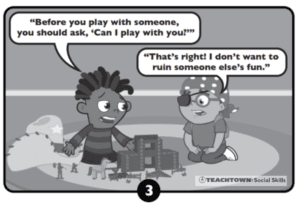
Social narratives have been documented to assist in addressing behavior challenges, learning coping and social skills, working through interpersonal interactions/issues, practicing conflict resolution, and understanding new perspectives. These are only a few examples of the uses of a social narrative.
They are a versatile and adaptable tool that can be used to meet the needs of a variety of different situations that may arise for a learner with ASD.
Social narratives detail a social situation that the learner may soon encounter. The narrative showcases applicable cues in the upcoming event and provides samples of different responses the learner can engage in. Social narratives are typically short, concise, and from the learner’s perspective.
Educators often use social narratives to help learners adjust to changes in their typical routines so they may anticipate upcoming events and adapt their behavior accordingly.
“In my classroom, we used social stories often. I especially liked to use them for novel, but important, events like tornado drills, special visits, and field trips to help students know what to expect. We used social narratives to teach what happens during a fire drill at the beginning of the year, and then we would revisit as needed as the year progressed. Once, a student joined my class later in the year, and we had a fire drill before I had an opportunity to pre-teach this event. This student was understandably distressed by the sudden alarm bells! Upon return to the classroom, I reviewed the social narrative with the student to help explain the event. I also reviewed the story with the student periodically and kept visuals from the story in the emergency bag we took with us during a fire drill. The next time we had a fire drill, they knew they could cover their ears, and moving quickly from the classroom would mean they could get away from the loud noise faster. Now that the student was prepared, they were able to use what they learned and get to the door right away.”
Following the use of Kristina’s social narrative of a fire drill, the students knew what routines to follow and what to expect the next time there was a fire drill in the classroom. Through the use of these social narratives, learners with ASD receive concrete instruction to help them to better understand the social standards in the upcoming event.
When implementing social narratives in your classroom, the National Professional Development Center on Autism Spectrum Disorders recommends the following 10 steps:
Comic strips are one example of a social narrative. See one of TeachTown’s comic strips from its Social Skills solution below.
Please keep in mind, all social narratives should be individualized according to the students’ needs to increase efficacy and reach the target skill and/or behavior change.
National Professional Development Center on Autism Spectrum Disorders. (2010, October). Evidence-based practice brief: social narratives. Retrieved January 15, 2022, from https://autismpdc.fpg.unc.edu/sites/autismpdc.fpg.unc.edu/files/imce/documents/Social-Narratives-Complete-10-2010.pdf